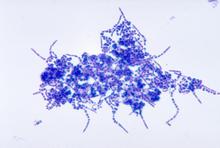Newsdate: Wednesday February 08, 2023 - 11:00 am
Location: GILROY, California
Horse owners that ride or work their horses during winter weather in wet and muddy conditions often discover that their horse has developed dermatitis on the underbelly and legs. This condition is often referred to as hunting dermatitis because it is relatively common in horses used for hunting purposes during late fall, winter and early spring.

Dermatophilus congolensis - Cause of dermatitis in horses
Horse owners that ride or work their horses during winter weather in wet and muddy conditions often discover that their horse has developed dermatitis on the underbelly and legs.
Hunting dermatitis is also known as ventral trunk mud fever and is a form of pastern dermatitis that affects horses working or competing in wet and muddy conditions during the colder months.
This bacterial skin condition affects the belly and inside of the fore and hind legs. Clinical signs are likely to appear soon after the horse contracts the Dermatophilus congolensis causing the condition, often on the evening of a hunting day.
Veterinary consultation may be needed if the horse is very sore. If a mild case, careful owner management can be successful. Mild antiseptic shampoo in warm water should be used to remove mud, drying the area by using clean towels. In addition, horse owners should make sure that bedding is clean and, if necessary, bedding should be replaced.
With a mild case, the horse is likely to be off work for a number of days and concentrate feed should be reduced accordingly.
Veterinary treatment must be sought for severe cases or mild cases which fail to respond to owner management or quickly resolve. Veterinary treatment usually involves oral antibiotic therapy.
As with all other Dermatophilosis conditions, all treatments should be continued until all of the affected skin is healed. Close attention should be given to proper hygiene and maintained throughout the duration of the infection to minimize the risk of re-infection and further complications.
Note: Article is an updated reposting of an article published in January 2013
